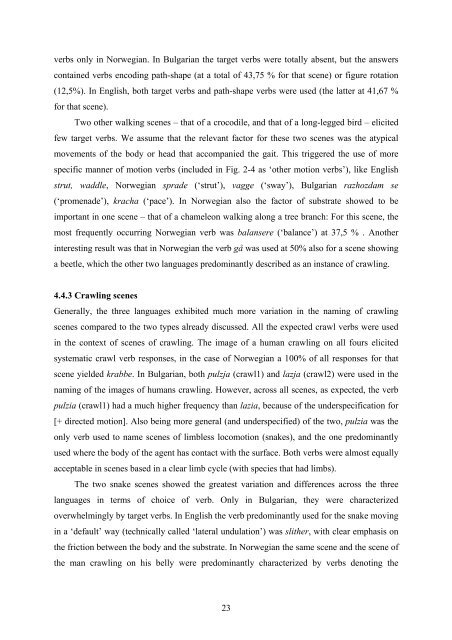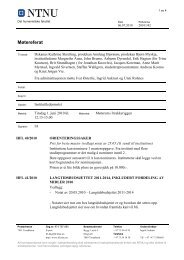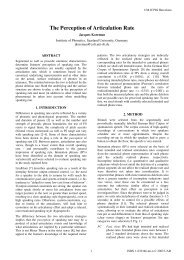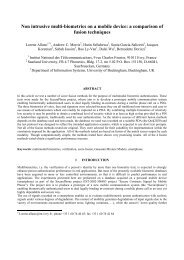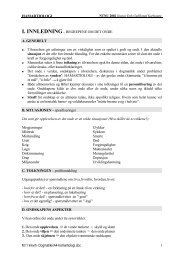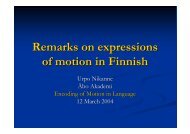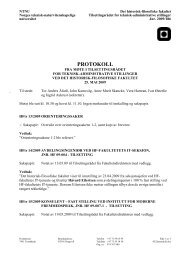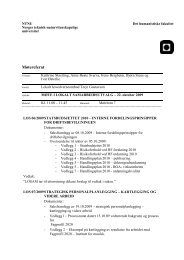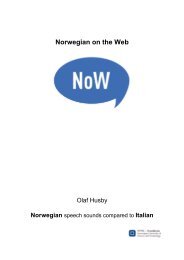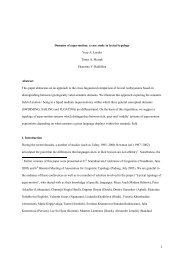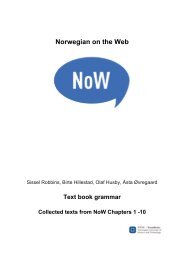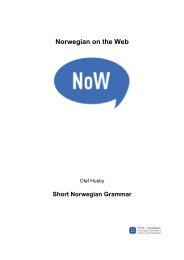In press: In: Dimitrova-Vulchanova, M - NTNU
In press: In: Dimitrova-Vulchanova, M - NTNU
In press: In: Dimitrova-Vulchanova, M - NTNU
Create successful ePaper yourself
Turn your PDF publications into a flip-book with our unique Google optimized e-Paper software.
verbs only in Norwegian. <strong>In</strong> Bulgarian the target verbs were totally absent, but the answers<br />
contained verbs encoding path-shape (at a total of 43,75 % for that scene) or figure rotation<br />
(12,5%). <strong>In</strong> English, both target verbs and path-shape verbs were used (the latter at 41,67 %<br />
for that scene).<br />
Two other walking scenes – that of a crocodile, and that of a long-legged bird – elicited<br />
few target verbs. We assume that the relevant factor for these two scenes was the atypical<br />
movements of the body or head that accompanied the gait. This triggered the use of more<br />
specific manner of motion verbs (included in Fig. 2-4 as ‘other motion verbs’), like English<br />
strut, waddle, Norwegian sprade (‘strut’), vagge (‘sway’), Bulgarian razhozdam se<br />
(‘promenade’), kracha (‘pace’). <strong>In</strong> Norwegian also the factor of substrate showed to be<br />
important in one scene – that of a chameleon walking along a tree branch: For this scene, the<br />
most frequently occurring Norwegian verb was balansere (‘balance’) at 37,5 % . Another<br />
interesting result was that in Norwegian the verb gå was used at 50% also for a scene showing<br />
a beetle, which the other two languages predominantly described as an instance of crawling.<br />
4.4.3 Crawling scenes<br />
Generally, the three languages exhibited much more variation in the naming of crawling<br />
scenes compared to the two types already discussed. All the expected crawl verbs were used<br />
in the context of scenes of crawling. The image of a human crawling on all fours elicited<br />
systematic crawl verb responses, in the case of Norwegian a 100% of all responses for that<br />
scene yielded krabbe. <strong>In</strong> Bulgarian, both pulzja (crawl1) and lazja (crawl2) were used in the<br />
naming of the images of humans crawling. However, across all scenes, as expected, the verb<br />
pulzia (crawl1) had a much higher frequency than lazia, because of the underspecification for<br />
[+ directed motion]. Also being more general (and underspecified) of the two, pulzia was the<br />
only verb used to name scenes of limbless locomotion (snakes), and the one predominantly<br />
used where the body of the agent has contact with the surface. Both verbs were almost equally<br />
acceptable in scenes based in a clear limb cycle (with species that had limbs).<br />
The two snake scenes showed the greatest variation and differences across the three<br />
languages in terms of choice of verb. Only in Bulgarian, they were characterized<br />
overwhelmingly by target verbs. <strong>In</strong> English the verb predominantly used for the snake moving<br />
in a ‘default’ way (technically called ‘lateral undulation’) was slither, with clear emphasis on<br />
the friction between the body and the substrate. <strong>In</strong> Norwegian the same scene and the scene of<br />
the man crawling on his belly were predominantly characterized by verbs denoting the<br />
23


